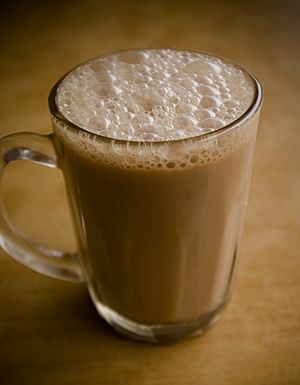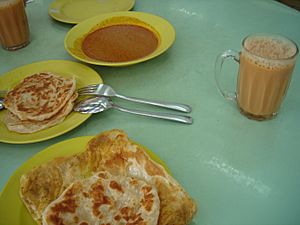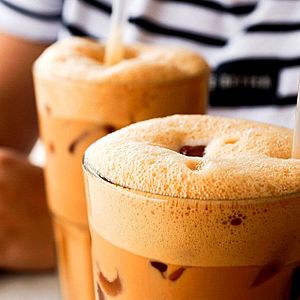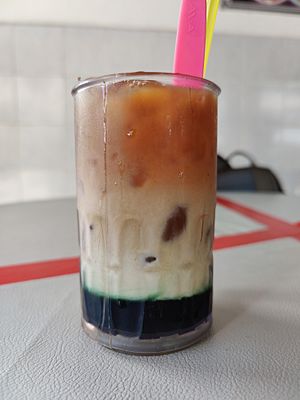Teh tarik facts for kids
 |
|
| Type | Beverage |
|---|---|
| Place of origin | Malaysia |
| Region or state | Malay peninsula |
| Created by | Indian immigrants in the Malay peninsula |
| Serving temperature | Hot |
| Similar dishes | Milk tea, including Burmese milk tea and Hong Kong-style milk tea |
Teh tarik is a popular hot milk tea drink. You can find it in restaurants and outdoor stalls across Southeast Asian countries like Malaysia, Indonesia, Singapore, and Thailand. Its name means "pulled tea" because of how it's made. It's made from strong black tea mixed with sweet condensed milk. It's even the national drink of Malaysia!
Contents
What Does Teh Tarik Mean?
The name Teh tarik comes from two languages. Teh means "tea" and comes from the Hokkien Chinese word for tea. Tarik means "pulled" and comes from the Malay word. So, Teh tarik literally means "pulled tea."
Where Did Teh Tarik Come From?

Teh tarik started with Indian Muslim immigrants in the Malay Peninsula. After World War II, they set up drink stalls near rubber plantations. They served this tea to the workers there.
For a long time, teh tarik has been a favorite drink in British Malaya and Singapore. People often enjoy it with Roti canai, a popular breakfast in Malaysia. In Singapore, it's often served with prata, which is similar to roti canai.
Making teh tarik is a bit like a show! The person making it pours the tea from a high distance. They make a long stream of tea without spilling it. This is fun for both locals and tourists to watch. In Malaysia, there are even competitions where people show off their teh tarik pouring skills. The Malaysian government sees teh tarik, along with nasi lemak, as an important part of their food heritage.
How Is Teh Tarik Made?
The tea mixture is poured back and forth. It goes between two cups from a height. This creates a thick, frothy top. This pouring also cools the tea to the perfect temperature. It mixes the tea and condensed milk very well. This process also makes the flavor better.
Sometimes, people ask for "kurang manis." This means "less sweet." Teh tarik is usually made quite sweet. So, if you don't like very sugary drinks, you can ask for it less sweet.
Different Kinds of Teh Tarik
- Teh ais is iced tea with condensed milk. It's simply served with ice cubes. You might also hear it called teh tarik ping or teh tarik ais.
- Teh tarik madu is teh tarik mixed with honey. It's usually served cold.
- Teh halia is teh tarik with ginger flavor.
- Teh madras is popular in Sabah and Labuan. It has frothed milky tea layered on top of hot milk.
- Teh-C is tea made with unsweetened evaporated milk. Regular teh tarik uses sweetened condensed milk. Vendors usually add sugar to Teh-C unless you ask for "kosong." Kosong means "zero" or "none" in Malay. It means you don't want sugar. The "C" in Teh-C comes from "Carnation," a well-known brand of evaporated milk.
- Teh-C Peng Special is a three-layered tea drink. It has black tea, milk, and palm sugar syrup.
- Teh-C ais is the iced version of Teh-C.
- Teh-O is black tea with no milk or creamer at all. The "O" means "original." Like Teh-C, sugar is usually added. But if you ask for "Teh-O kosong," it means no sugar.
- Teh O ais is the iced version of Teh-O.
- Kopi tarik is a local coffee drink. It's made from dark roasted coffee with margarine and sugar. Then it's sweetened with condensed milk and "pulled" to make it frothy. Some places also make drinks with Milo or Nescafe using the "tarik" pulling method.
Teh Tarik in Culture
Teh tarik has become a symbol of bringing people together. It's a common drink for many different cultural groups. In Malaysia, schools and other groups host "Teh tarik sessions." During these sessions, people talk and find common ground. They learn to appreciate their differences.
See also
 In Spanish: Teh Tarik para niños
In Spanish: Teh Tarik para niños



